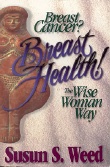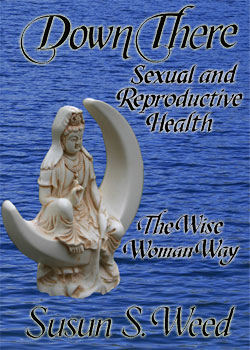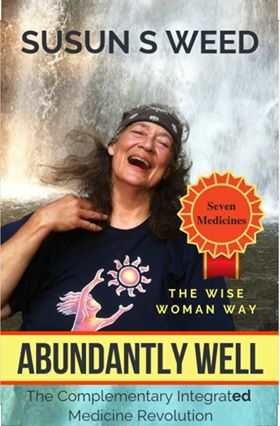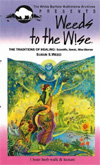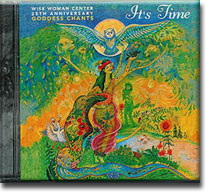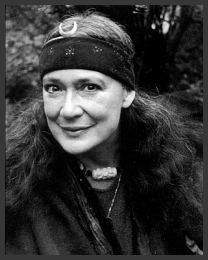OPTIMUM NUTRITION: Cooked or Raw?
c. 2004 Susun S Weed
Which is better: cooked food or raw? Taking nothing for granted or gospel, I set out to find out for myself the answer to this important question.
First, I asked, what is meant by "raw food" and what is meant by "cooked food?" One cannot simply say that raw is uncooked, for there are raw food "cookbooks." Nor is cooking simply the application of heat through boiling, baking, or frying, as I soon discovered. Ripening itself is one form of natural cooking; others are described later.
Second, I wondered, what did my ancestors eat? And was it raw or cooked?
Third, I questioned, how do enzymes in foods affect digestion and health?
And fourth, I attempted to sum it up, is there an advantage to cooking?
The answers weren't as simple as one might suspect, however. The answers to these questions combine in interesting ways, and open up other questions in their answering.
To begin with the second question: Our most primitive ancestors, those who lived several million years ago, most likely ate raw food. The majority of what they ate was animal protein: muscle meats, organ meats, eggs, and insects.
Present day examples of peoples who primarily eat raw animal protein include the Inuit of the far North and the Masai of Africa, known for their health and freedom from disease.
Research done by Dr. Pottenger in the mid-twentieth century revealed that raw meat and milk contained enzymes necessary for digestion. He showed that heat deactivated their enzymes (www.westonaprice.org). His conclusion was that raw meat, fish, milk and eggs provide more nutrients and are more easily digested.
This is not true of plant foods, however. Vegetables and fruits do contain enzymes -- if picked fully ripe -- but their enzymes have no function in their own digestion, although papaya, pineapple, and kiwi fruit contain enzymes that digest meat (An interesting aside - these fruits are tropical fruits that help digest and destroy, in the digestive systems of people and animals, the parasites that are found in those regions, and only incidentally digest other kinds of meat). Many plant enzymes interfere with digestion, so our bodies destroy them.Cooked food was the preference of most of our ancestors. Archaeologists have found evidence of fire in sites occupied by hominids as far back as a million years ago, but cannot say exactly when we began to use fire to cook food.
Certainly by about ten thousand years ago, when cultivation of grains and beans -- hard foods which absolutely require cooking -- became widespread, our ancestors were regularly and routinely cooking their food.
Most current aboriginal people also cook their food; in New Zealand, for instance, I found the Maori jealously guarding natural hot pools used to cook their food.
Is there an advantage to cooking? It depends on how we cook - or, more basically, how we define cooking - and whether we are eating animals or plants. Animal cells are surrounded by a membrane. This thin membrane is easily dissolved by digestive juices, releasing the nutrients stored in the cell. Fast, high-heat cooking will toughen these membranes, thus slowing digestion and impairing nutrient uptake.
For an illustration of this, think of how tough an overcooked piece of meat can become; chewing, an important part of digestion, is much more difficult. Slow, low-heat cooking dissolves the membrane, making digestion and nutrient uptake much easier. If the idea of raw meat turns your stomach, eat soups and stews instead.
Plant cells are surrounded by a wall. This wall is designed to resist breakage and to protect the stored nutrition in plant cells. Digestive juices act on the cell walls of plants little if at all; take a look in the toilet the day after next time you eat corn on the cob to see how true this is. Cooking, which can be expanded to include her sisters freezing, drying, sprouting, fermenting, and preserving in oil, breaks the cell wall and is necessary to liberate nutrients from plant cells.
Cooked vegetables and fruits, grains, and beans provide more nutrients and are more easily digested than raw ones.A Haiku-like verse that could sum this up is:
Chewing what is raw,
how can one smile?
Muscles of the jaw too tense.A macrobiotic diet, the only vegetarian diet shown to put cancer in remission, consists of cooked food exclusively. Around the world, well-cooked meat broths -- think chicken soup -- are the food of choice for convalescents.
Cooked plants are far more nourishing than raw plants, whether we look at vegetables, fruits, nuts, grains, or pulses (beans). Cooking not only breaks the cell wall, liberating minerals to our bodies, it actually enhances and activates many vitamins.
This is true especially of the carotenes, used to make vitamin A, and other antioxidants in plants. Research found that the longer the corn is cooked and the hotter the temperature, the greater the amount of antioxidants in the corn.
This also applies to vitamin C. A baked potato contains far more vitamin C than a raw potato. And sauerkraut (cabbage cooked by fermentation) contains up to ten times as much vitamin C as raw cabbage.
Some vitamins do leach into cooking water. Cooking with little or no water (for instance, steaming or braising) reduces vitamin loss in vegetables such as broccoli from 97% to 11%.
Note, however, that the vitamins aren't lost or destroyed, but merely transferred to the cooking water. Using that water for soup stock, or drinking it, insures that you ingest all the nutrients, and in a highly absorbable form.
Transferring nutrients into water, such as by making nourishing herbal infusions and healing soups, and then ingesting them is far more effective, in my experience, than wheat grass juice, green drinks, or any kind of nutritional supplement. It is, in fact, one of the best ways to optimally nourish oneself that I have found in three decades of paying attention to health.
Even if some vitamins are lost in cooking, people absorb more of what is there from cooked foods. Several recent studies measured vitamin levels in the blood after eating raw and cooked vegetables. "Subjects who ate cooked veggies absorbed four to five times more nutrients than those who ate raw ones," reported researchers at the Institute of Food Research in 2003.
There is no simple answer to the question "raw or cooked?" But for simplicity's sake, I say, eat your food cooked. This is especially the case if you choose to eat a diet high in whole grains, beans, nuts, vegetables, and fruit. That's the way I eat, so I cook most of my food. But I keep a herd of dairy goats so I can have raw milk, raw milk cheese, and raw milk yogurt. I do enjoy raw meat and raw fish on occasion, but more often slow cook my goat into barbeque, a special kind of healing "soup" I learned to make in Texas.
The cook dances with the element fire. The cook stirs the cauldron. The cook transforms the parts and turns them into our whole. Blessings on the cook. Praise to the cook. May your food be well cooked.
References:
Aiello, L.C.; Wheeler, P. "The expensive tissue hypothesis: the brain and the digestive system in human and primate evolution." Current Anthropology. 36:199-221, 1995
Alvi, Shahnaz; Khan, K.M.; Sheikh, Munir A.; Shahid, Muhammad. "Effect of Peeling and Cooking on Nutrients in Vegetables." Pakistan Journal of Nutrition 2 (3): 189-191, 2003
Blumenschine, Robert. "Hominid carnivory and foraging strategies, and the socio-economic function of early archaeological sites," pp. 51-61. In: Whiten, A.;
Widdowson, E.M. (eds.) Foraging Strategies and Natural Diet of Monkeys, Apes, and Humans. Oxford, England: Clarendon Press. 1992
Bower, Bruce. "Ancient Origins of Fire Use." Science News. 157(18): 287, April 29, 2000
Cobb, Kristin. "Processing Corn Boosts Antioxidants." Science News. 162(9): 141, Aug. 31, 2002
Davidson; Noble "When did language begin?" p. 46. In: Burenhult, Goran (ed.) The First Humans: Human Origins and History to 10,000 B.C. New York, NY: Harper-Collins Publishers. 1993
de Pee, S.; West, C.; Muhlilal, D.; Hautvast, J. "Lack of improvement in vitamin A status with increased consumption of dark-green leafy vegetables." Lancet. 346:75-81, 1995
Foley, Robert. Humans Before Humanity. Cambridge, Mass: Blackwell Publishers. 1995
Groves. "Our earliest ancestors," pp. 33-40, 42-45, 47-52. In: Burenhult, Goran (ed.) The First Humans: Human Origins and History to 10,000 B.C. New York, NY: Harper-Collins Publishers. 1993
James, Steven. "Hominid use of fire in the lower and middle Pleistocene. A review of the evidence." Current Anthropology. 30:1-26, 1990
Megarry, Tim. Society in Prehistory: The Origins of Human Culture. New York, NY: New York University Press. 1995
Oste, R.E. "Digestibility of Processed Food Protein." Adv Exp Med Biol. 289: 371-88, 1991
Parker, R.S. "Absorption, metabolism, and transport of carotenoids." The FASEB Journal. 10:542-551, 1996
Preet, K.; Punia, D. "Antinutrients and Digestibility (in vitro) of Soaked, Dehulled and Germinated Cowpeas. Nutr Health. 14 (2): 109-117, 2000
Rukang, Ru; Shenglong, Lin. "Peking man." Scientific American. 248(6): 86-94, June 1983.
Sillen, A. "Strontium-calcium (Sr/Ca) ratios of Australopithecus robustus and associated fauna from Swartkrans." Journal of Human Evolution. 23:495-516, 1992
Sussman, R.W. "Species-specific dietary patterns in primates and human dietary adaptations," pp. 151-179. In: Spuhler, J.N. (ed.) The Evolution of Human Behavior: Primate Models. State University of New York Press. 1987
Tortora, G..J.; Anagnostakos, N.P. Principles of Anatomy and Physiology, New York, NY: Harper and Row. 1981
Walker, Alan; Shipman, Pat. The Wisdom of the Bones: In Search of Human Origins. New York, NY: Alfred A. Knopf. 1996
Young, V.; Pellett, P. "Plant proteins in relation to human protein and amino acid nutrition." American Journal of Clinical Nutrition. 59:1203S-1212S, 1996
Vibrant, passionate, and involved, Susun Weed has garnered an international reputation for her groundbreaking lectures, teachings, and writings on health and nutrition. She challenges conventional medical approaches with humor, insight, and her vast encyclopedic knowledge of herbal medicine. Unabashedly pro-woman, her animated and enthusiastic lectures are engaging and often profoundly provocative.
Susun is one of America's best-known authorities on herbal medicine and natural approaches to women's health. Her four best-selling books are recommended by expert herbalists and well-known physicians and are used and cherished by millions of women around the world.
For permission to reprint this article, contact us at:www.ashtreepublishing.com/contact
Visit Susun Weed at: www.susunweed.com and www.wisewomanbookshop.com
Susun Weed’s books include:
Wise Woman Herbal for the Childbearing Year
Author: Susun S. Weed.
Simple, safe remedies for pregnancy, childbirth, lactation, and newborns. Includes herbs for fertility and birth control. Foreword by Jeannine Parvati Baker. 196 pages, index, illustrations.
Order at: www.wisewomanbookshop.com
Healing Wise
Author: Susun S. Weed.
Superb herbal in the feminine-intuitive mode. Complete instructions for using common plants for food, beauty, medicine, and longevity. Introduction by Jean Houston. 312 pages, index, illustrations.
Order at: www.wisewomanbookshop.com

NEW Menopausal Years the Wise Woman Way
Author: Susun S. Weed.
The best book on menopause is now better. Completely revised with 100 new pages. All the remedies women know and trust plus hundreds of new ones. New sections on thyroid health, fibromyalgia, hairy problems, male menopause, and herbs for women taking hormones. Recommended by Susan Love MD and Christiane Northrup MD. Introduction by Juliette de Bairacli Levy. 304 pages, index, illustrations.
Order at: www.wisewomanbookshop.com
For excerpts visit: www.menopause-metamorphosis.com
Breast Cancer? Breast Health!
Author: Susun S. Weed.
Foods, exercises, and attitudes to keep your breasts healthy. Supportive complimentary medicines to ease side-effects of surgery, radiation, chemotherapy, or tamoxifen. Foreword by Christiane Northrup, M.D. 380 pages, index, illustrations.
Order at: www.wisewomanbookshop.com
Down There: Sexual and Reproductive Health the Wise Woman Way
Publication date: June 21, 2011
Author: Susun S. Weed
Simple, successful, strategies cover the entire range of options -- from mainstream to radical -- to help you choose the best, and the safest, ways to optimize sexual and reproductive health. Foreword: Aviva Romm, MD, midwife, 484 pages, Index, illustrations.
Order at: www.wisewomanbookshop.com
Abundantly Well - Seven Medicines The Complementary Integrated Medical Revolution
Publication date: December 2019
Author: Susun S. Weed
Seven Medicines build foundational health and guide you to the best health care when problems arise. Includes case studies, recipes, exentsive references and resources. Introduction by Patch Adams illustrated by Durga Yael Bernhard 352 pages, index, illustrations
Order at: www.wisewomanbookshop.com
Susun Weed's Video & CD's:Weeds to the Wise DVD Video
Visit Susun's farm for a weed walk. Hear her talk on the Three Traditions of Healing. Make infusion with her. Fun! (1 hour VHS video) Please note: this VHS video tape is in NTSC format which may not be compatible with video players outside of the USA and Canada.
Order at: www.wisewomanbookshop.com
Susun Weed's "It's Time"
Wise Woman Center
25th Anniversary Celebration CD
GODDESS CHANTS CD
Visit www.goddesschants.com to hear all the songs, read lyrics &
learn about the artists.
18 Wise Woman Songs & Chants from the heart
For Wholesale orders see our terms letter or contact us at:
Ash Tree Publishing PO Box 64 Woodstock, NY 12498 ~
Website: www.wisewomanbookshop.com ~ E-mail: susunweed@herbshealing.com
Susun Weed, green witch and wise woman, is an extraordinary teacher with a joyous spirit, a powerful presence, and an encyclopedic knowledge of herbs and health. She is the voice of the Wise Woman Way, where common weeds, simple ceremony, and compassionate listening support and nourish health/wholeness/holiness. She has opened hearts to the magic and medicine of the green nations for decades. Ms. Weed's Six herbal medicine books focus on women's health topics including: menopause, childbearing, and breast health. Visit her site www.susunweed.com for information on her workshops, apprenticeships, correspondence courses and more! Venture into the Menopause site www.menopause-metamorphosis.com to learn all about the Menopausal Years the Wise Woman Way.
Join Susuns Mentorship site for personal one on one mentorship! We also invite you to visit our commerce site www.wisewomanbookshop.com to learn about our Wise Woman publications, workshops, correspondence courses. As well as online courses at Wise Woman School.
back to articles index
back to press kit
© Susun Weed -Wise Woman Center
~ Disclaimer & Privacy Policy ~


